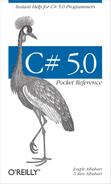A struct is similar to a class, with the following key differences:
A struct is a value type, whereas a class is a reference type.
A struct does not support inheritance (other than implicitly deriving from
object, or more precisely,System.ValueType).
A struct can have all the members a class can, except for a parameterless constructor, a finalizer, and virtual members.
A struct is used instead of a class when value-type semantics are desirable. Good examples are numeric types, where it is more natural for assignment to copy a value rather than a reference. Because a struct is a value type, each instance does not require instantiation of an object on the heap; this can incur a useful saving when creating many instances of a type. For instance, creating an array of a value type requires only a single heap allocation.
